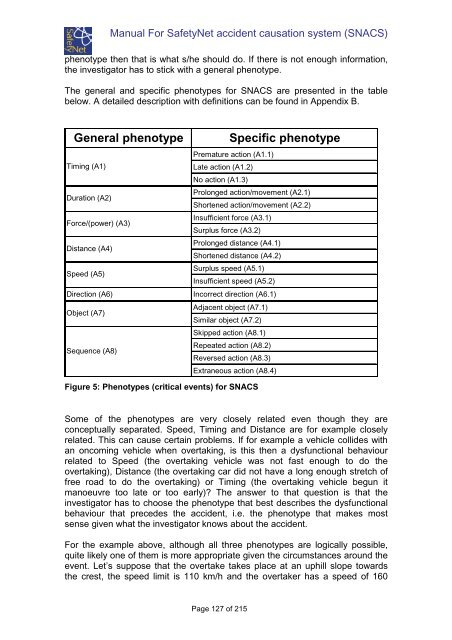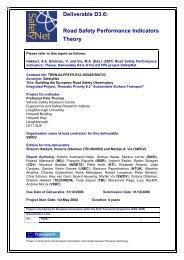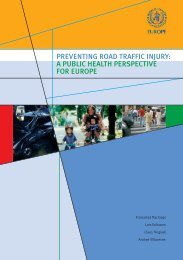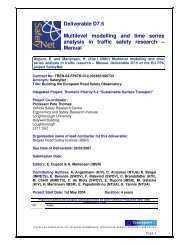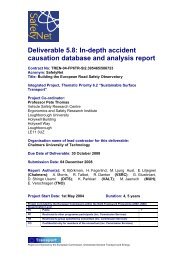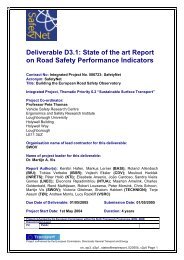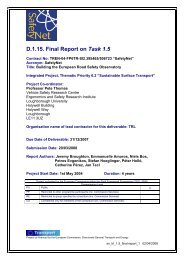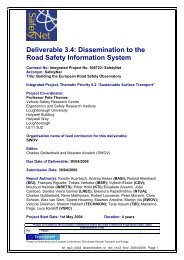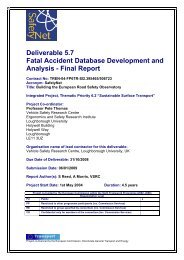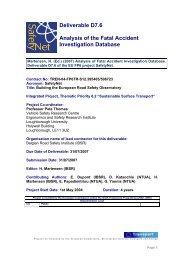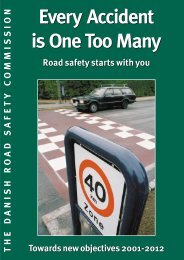Glossary of Data Variables for Fatal and accident causation ... - ERSO
Glossary of Data Variables for Fatal and accident causation ... - ERSO
Glossary of Data Variables for Fatal and accident causation ... - ERSO
You also want an ePaper? Increase the reach of your titles
YUMPU automatically turns print PDFs into web optimized ePapers that Google loves.
Manual For SafetyNet <strong>accident</strong> <strong>causation</strong> system (SNACS)<br />
phenotype then that is what s/he should do. If there is not enough in<strong>for</strong>mation,<br />
the investigator has to stick with a general phenotype.<br />
The general <strong>and</strong> specific phenotypes <strong>for</strong> SNACS are presented in the table<br />
below. A detailed description with definitions can be found in Appendix B.<br />
General phenotype<br />
Timing (A1)<br />
Duration (A2)<br />
Force/(power) (A3)<br />
Distance (A4)<br />
Speed (A5)<br />
Direction (A6)<br />
Object (A7)<br />
Sequence (A8)<br />
Specific phenotype<br />
Premature action (A1.1)<br />
Late action (A1.2)<br />
No action (A1.3)<br />
Prolonged action/movement (A2.1)<br />
Shortened action/movement (A2.2)<br />
Insufficient <strong>for</strong>ce (A3.1)<br />
Surplus <strong>for</strong>ce (A3.2)<br />
Prolonged distance (A4.1)<br />
Shortened distance (A4.2)<br />
Surplus speed (A5.1)<br />
Insufficient speed (A5.2)<br />
Incorrect direction (A6.1)<br />
Adjacent object (A7.1)<br />
Similar object (A7.2)<br />
Skipped action (A8.1)<br />
Repeated action (A8.2)<br />
Reversed action (A8.3)<br />
Extraneous action (A8.4)<br />
Figure 5: Phenotypes (critical events) <strong>for</strong> SNACS<br />
Some <strong>of</strong> the phenotypes are very closely related even though they are<br />
conceptually separated. Speed, Timing <strong>and</strong> Distance are <strong>for</strong> example closely<br />
related. This can cause certain problems. If <strong>for</strong> example a vehicle collides with<br />
an oncoming vehicle when overtaking, is this then a dysfunctional behaviour<br />
related to Speed (the overtaking vehicle was not fast enough to do the<br />
overtaking), Distance (the overtaking car did not have a long enough stretch <strong>of</strong><br />
free road to do the overtaking) or Timing (the overtaking vehicle begun it<br />
manoeuvre too late or too early) The answer to that question is that the<br />
investigator has to choose the phenotype that best describes the dysfunctional<br />
behaviour that precedes the <strong>accident</strong>, i.e. the phenotype that makes most<br />
sense given what the investigator knows about the <strong>accident</strong>.<br />
For the example above, although all three phenotypes are logically possible,<br />
quite likely one <strong>of</strong> them is more appropriate given the circumstances around the<br />
event. Let’s suppose that the overtake takes place at an uphill slope towards<br />
the crest, the speed limit is 110 km/h <strong>and</strong> the overtaker has a speed <strong>of</strong> 160<br />
Page 127 <strong>of</strong> 215


